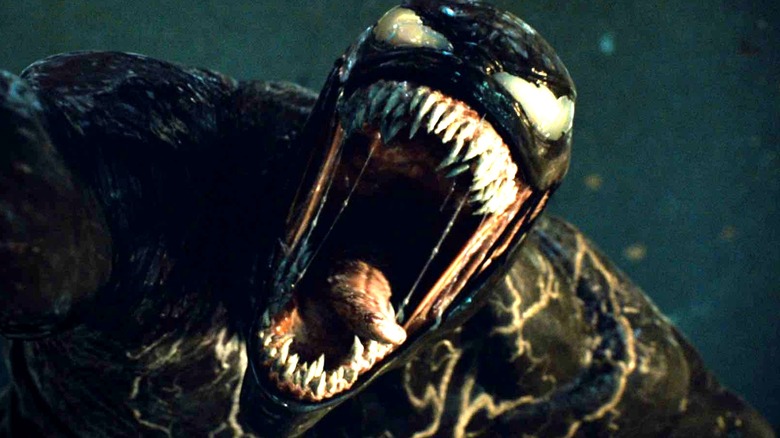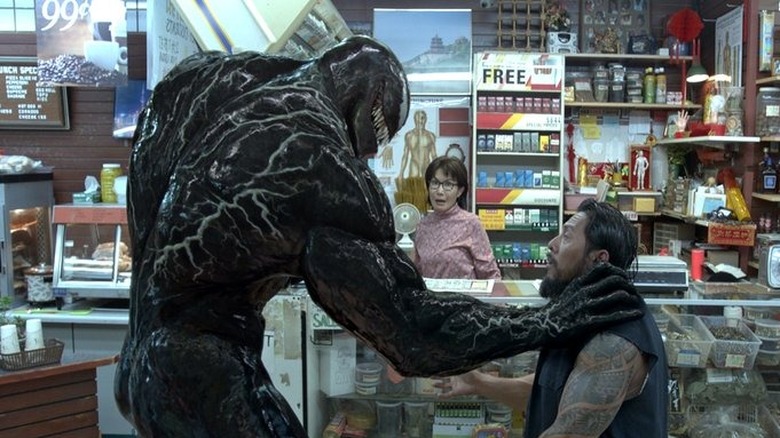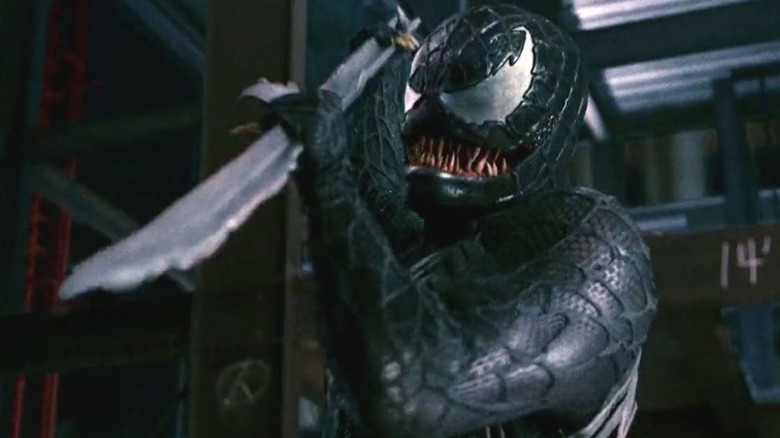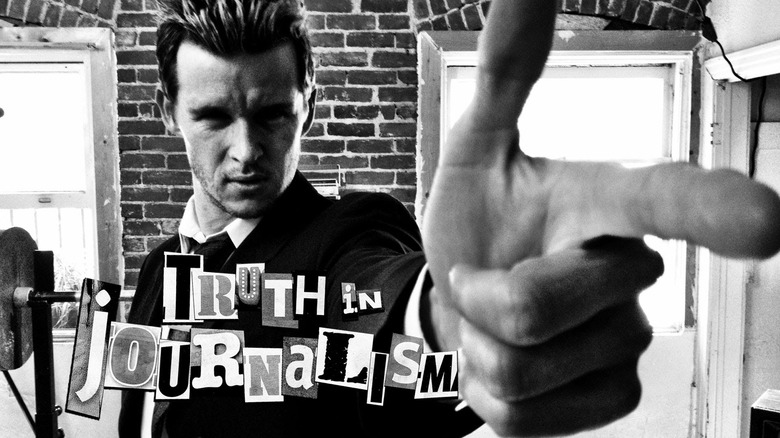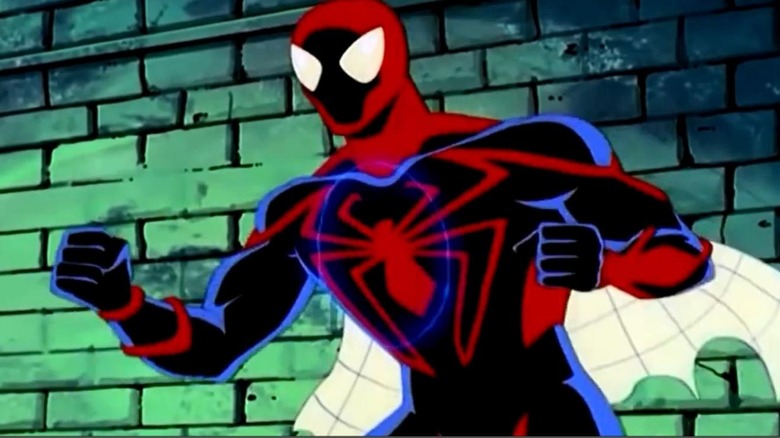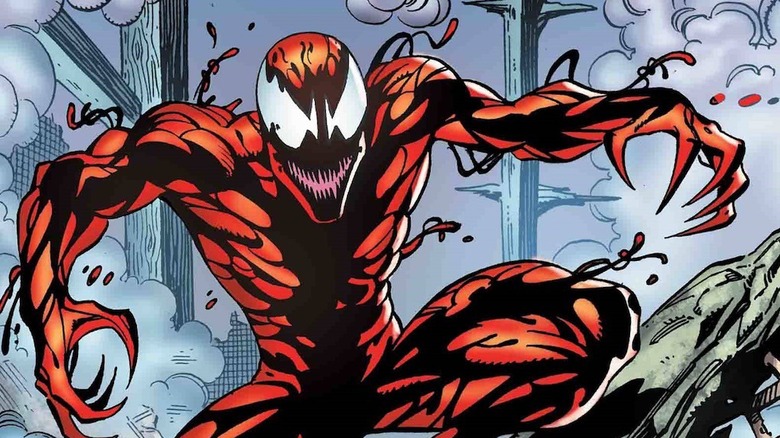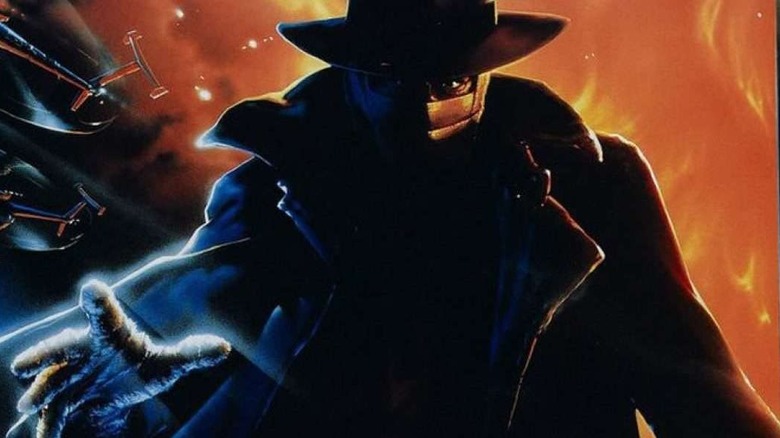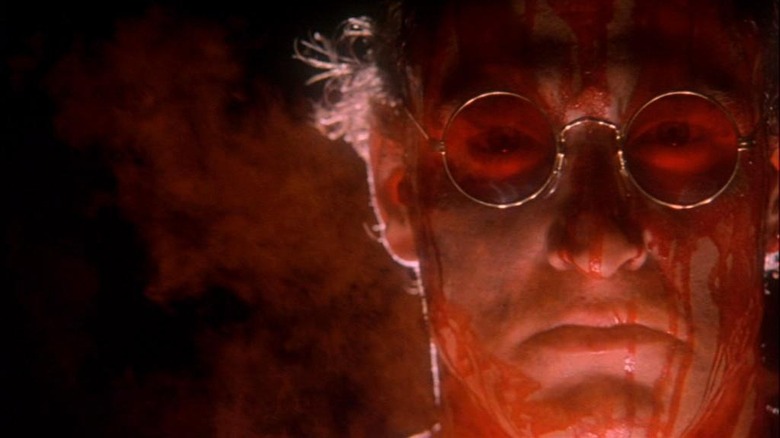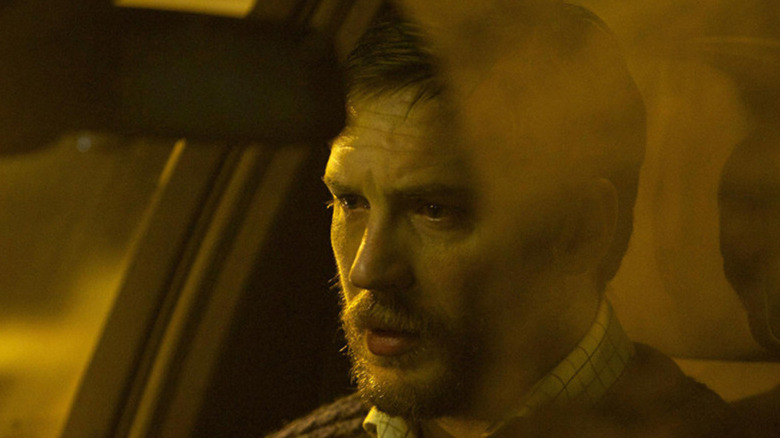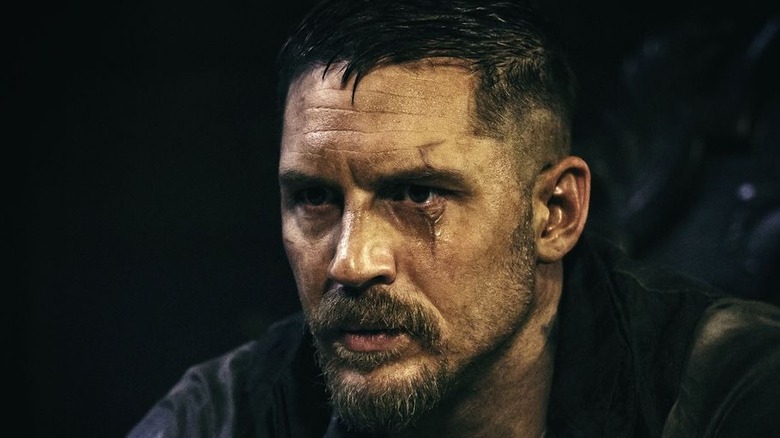What To Watch Before Venom: Let There Be Carnage
Film trailers are an act of escalation. At minimum, they exist to make the public aware of a project. At best, a trailer can turn a movie with buzz into something you must see, right now, no excuses. In the forever war for pop-culture dominance, trailers lead the movie studios' charge — which means they're often battling each other for supremacy. Getting the internet's attention, however, is a perilous task; it's hard to do, and when it backfires, it backfires big.
Which is why, on May 10th, 2021, "Venom: Let There Be Carnage" accomplished something amazing. Look, if a Gershwin-crooning parasite cooking breakfast badly doesn't escalate your interest in "Venom: Let There Be Carnage," then I don't know what to tell you. Andy Serkis' forthcoming film looks like a funnier and more menacing affair than the blockbuster that preceded it, functioning as rom-com horror alternative to the other comic book movies dropping this fall. Almost as importantly, its storyline draws from 30-plus years of comics canon, the filmographies of both Serkis and star Tom Hardy, and the heyday of '90's superhero films. That's makes it "must see" for me.
If you want to enrich your "Venom: Let There Be Carnage" experience (or aren't sure how to prepare for it), here are 10 films and television episodes to watch before you hit the theater.
Venom
When noted video essayist Patrick H Willems called "Venom" "the third best superhero film of 2003," his point was more than Letterboxd fodder: Ruben Flesicher's film was CGI-saturated, dully hued, and slow to achieve narrative lift-off. It was far more "Daredevil" than "The Dark Knight. Why, then, it's lasting appeal?
Two words: Tom Hardy. Tom Hardy put his heart and soul into playing both Eddie Brock and the film's titular symbiote, melding his mainstream charm with gonzo choices — choices like diving into a lobster tank to feed on frightened crustaceans (a moment that Hardy improvised), or giving Venom the line, "Like a turd ... in the wind" (again, an improv). "Venom" is to Tom Hardy what "Scent of a Woman" was to Pacino: the moment when a great actor gives a performance so ridiculous, yet so inspired that it becomes both perfect art and parody. Tom Hardy is why "Venom" holds up. He makes the film worth watching.
But if Hardy's performance isn't enough, "Venom" is chock full of plot details and characters that "Venom: Let There Be Carnage" builds on, including a post-credits scene that introduces Woody Harrelson's Cleatus Kassidy, the villain of "Let There Be Carnage." You must watch "Venom" first.
Spider-Man 3
Many casual filmgoers don't remember "Spider-Man 3." That's understandable. It's mostly been purged from collective memory by six subsequent Spider-Man movies, and reduced to a pretty great gag in "Spider-Man: Into the Spider-Verse." Does it deserve re-appreciation? Depends on who you ask. But what's barely up for debate is that Tom Hardy's gonzo take on Venom doesn't make it to multiplexes if Topher Grace doesn't gun for mad-eyed and tragic menace as the character first. Like, really gun for it.
This isn't Grace's fault, just like it isn't Tom Brady's fault if he cannot dunk a basketball or hit a home run on cue. Grace was cast against type in a movie overcrowded with villains (the actor himself has practically said as much), but his inability to make Venom scary or sad was Sony's main argument for pivoting towards a funny, cool Venom 11 years later. To fully appreciate what "Venom" and "Venom: Let There Be Carnage" are doing with the character is to know "Spider-Man 3" backwards and forwards. Study up.
Venom: Truth in Journalism
If "Spider-Man 3" showed Sony that the cinematic Venom needed a tune-up, "Venom: Truth in Journalism" offered a chop-shop oil change. Joe Lynch's found-footage Eddie Brock fan film, released as part of Adi Shankar's "Bootleg Universe," features sprawling monologues, '80s rock, and French documentary crews; there's nothing it won't throw under the hood. The project was described by Shankar as mash up of the Belgian mockumentary "Man Bites Dog" and comic book movies, but it's ostensibly Marvel Comics' "Nightcrawler" (the 2014 thriller, not the X-Man).
To be fair: that's sort of why it works! Lynch isn't known for subtlety as a director (See "Mayhem", "Wrong Turn II", and so on), but a story-thirsty journalist who's also a human-eating symbiote hardly lends itself to understatement. And the film has more on its mind thematically than 2018's "Venom" and possibly "Let There Be Carnage," too, wrestling with the ethics of cinematic storytelling even as Eddie spews black bile and fights crime. Much like the leaked test footage of "Deadpool" proved the Merc with a Mouth could carry a movie, "Venom: Truth in Journalism" showed that audiences were ready for a stranger take on Eddie Brock. But if we're talking strange...
Spider Man Unlimited — "One Is the Loneliest Number"
"Spider-Man Unlimited" is a strange show. Its animation is firmly from the '90s, but it might take place far in the future; it's never really clear. It also poaches Spidey's cape from the 2099 comics and give Peter Parker an accent (Queens, maybe — again, it's hard to tell). But even if "One Is the Loneliest Number" contains questionable aesthetics and dicey dialogue (at one point, Venom says to Spider Man, "We always thought of you as a swinger"), the episode perfectly captures the co-dependent bond between Venom and Edward Brock. The pair are more than attached. They're each other's enablers.
Venom exacerbates Brock's hatred and self-loathing. Brock, in turn, brings Venom human meals. It's a non-stop cycle of toxicity. And as anyone who's been in a bad relationship knows, leaving is easier said than done. In this instance, "One Is the Loneliest Number" posits that Brock has been bonded to a symbiote for so long that he'll die without it in his system. It's an all-too-human fear rendered using comic book tropes, and it's the exact fear that "Venom: Let There Be Carnage" looks to exploit to both hilarious and moving ends. What's more, "One Is The Loneliest Number" also features a surreal depiction of Carnage himself, which brings us straight to...
Spider-Man: The Animated Series — "Carnage"
Carnage and Cletus Kassidy are itches that Eddie Brock must scratch. Whether they're causing violent mayhem on the streets or locked up tight in Ravencroft, they gnaw at his psyche. Eddie is never responsible for Carnage's actions, but he's fully innocent, either. This delicate and frightening dynamic was first captured on screen by 1994's "Spider-Man: The Animated Series," which spent much of its third season on symbiotes doing battle (War Machine, Iron Man, and cult favorite the Spot all make appearances as well). Venom and Carnage's terrifying tête-à-tête, however, is the focus of episode 11, "Carnage."
It's really impossible to understate how compelling and bone-chilling Carnage is here. As voiced by Scott Cleverdon, Carnage is charming even whilst hoisting a bloody axe over Spider-Man's head. His beguiling lack of humanity is enough to help Eddie find his own by episode's end, hinting at the chaotic face turn that would inspire both "Venom" and "Venom: Let There Be Carnage." The show — and all Spider-Man animated properties — are available on Disney+.
Darkman
"Darkman" was a reaction to Tim Burton's "Batman" — literally. When the powers-that-be wouldn't let "Evil Dead" director Sam Raimi make a movie based on Batman or the Shadow, the director decided to adapt one of his '30's-set short stories for the screen instead. Universal was hoping it would be a cash cow; those hopes were dashed, fast. Their loss was cinema's gain, however, because "Darkman" is Raimi cutting the breaks on his own aesthetic in the hopes of going full dollar-store crime novel. He succeeds. If you've never seen the trailer, now's the time.
And, in retrospect, "Darkman" is more than ahead of its time — it's the blueprint for the blueprint, the film that paved the way for Joel Schumacher and his kaleidoscopic Batman films, and later for Raimi's own "Spider-Man." But the influence of its gothic pulp tendencies can also be seen in grungy cult efforts like "The Crow," "Spawn," and even "Blade." "Venom: Let There Be Carnage" is a close cousin of those movies, all of which are pulpy pictures full of dark asylums and radical monsters. "Darkman" is the real deal. Check it out imminently.
Natural Born Killers
Few films are as simultaneously iconic and problematic as "Natural Born Killers." It is lurid and yet visionary, satirical while still glorifying violence. To watch it means debating the content of every frame, even if only with yourself. Unpacking everything in "Natural Born Killers" would take its own article. For our purposes, what you need to know is this: Woody Harrelson rules in it.
Prior to playing serial killer Mickey Knox, Harrelson had cornered the market on goofy, loveable schlubs. He was Woody Boyd in "Cheers." He was Billy Hoyle in "White Men Can't Jump." "Natural Born Killers" exploded that image. Harrelson is occasionally hysterical and consistently terrifying as a walking, evil-talking embodiment of the human id unleashed. Harrelson anchors "Natural Born Killers" with recognizable, if ugly, humanity, and based on the trailers, he does the same for the "Venom" sequel as Carnage. Harrelson should be drawing from the same quietly funny and menace-drenched playbook that made Knox so memorable. If you want to better appreciate his work, "Natural Born Killers" is the starting point.
Mowgli: Legend of the Jungle
Though Marvel and Sony have both turned to indie directors as of late, "Venom: Let There Be Carnage" director Andy Serkis, who made his name playing mo-cap characters like Gollum and Planet of the Apes' Caesar, already has a known IP effort under his belt: the ambitious, motion-capture heavy "Mowgli: Legend of The Jungle." It's a sprawling picture, one that never clicks so much as revs through fits and starts.
But besides revealing Serkis' taste for films with four-word subtitles, "Mowgli" suggests that Stephen Summers is Serkis' primary directorial influence. Like "The Jungle Book" director (we're talking about the 1994 live-action film, not the 2016 remake of the animated feature), Serkis stages deeply physical set-pieces (a battle in Sher Khan's cave is rife with live and CGI action, all of it visceral). He also pulls physically rich performances from on-set and mo-cap actors alike. Serkis is a sucker for physical comedy, too, finding time to put Mowgli through the slapstick ringer during a vine-swinging session.
Given all that, it's no wonder that Serkis was drawn to "Let There Be Carnage." The trailer alone suggests that motion capture, sudden violence, and a broad comic streak will be hallmarks of its story. A viewing of "Mowgli: Legend Of The Jungle" will help one better appreciate Serkis' efforts behind the camera.
Locke
We've discussed how Tom Hardy's dual performance as Eddie Brock and the symbiote is one of the core pleasures of "Venom," and the original film frequently pits them in heated conversation with each other, not unlike Edward Norton's character in "Fight Club." Eight years ago, however, Hardy perfected this skill in "Locke," which milks feature film-length tension out of a construction foreman who debates the choices that have brought him to a crossroads over the course of a long, solitary car ride. When Locke isn't talking with others over his speakerphone (leading to vocal cameos from Olivia Coleman, Andrew Scott, and the MCU's own Spider-Man, Tom Holland, among others), he's talking to himself, wrestling with the voice inside his head.
This tug-of-moral-war is rendered with crystalline clarity by Hardy, who has arguably never been better than he is as Ivan Locke. And director Steven Knight, whose cinematic experiments have ranged from effective to totally bugnuts, recognizes the universe-shifting gravity of watching Tom Hardy think. If you want to understand why Hardy excels even in the most bonkers moments of "Venom," "Locke" offers an excellent explanation.
Taboo
One of the more surprising tidbits from the "Venom: Let There Be Carnage" press release is that star Tom Hardy is credited as a co-writer on the film. And while very few had "moviesStar co-writes gnarly comic book movie" on their vision board for 2021, "Let There Be Carnage" isn't the first project Hardy has helped pen. That title belongs to FX and BBC's "Taboo," which ran for one season and barely made any impact anywhere.
That doesn't, however, mean that "Taboo" isn't worth watching. In fact, quite the opposite — "Taboo" takes a straightforward revenge narrative and makes it labyrinthian, eschewing traditional storytelling for grim, ecstatic visuals and atmospheric world building. It also confirms Hardy's attraction characters whose heads wage war against their hearts. And given that the "Taboo" scripts also marry genre conventions to unexpected grace notes for flawed protagonists, it strongly hints at where "Venom: Let There Be Carnage" might be headed. Don't overlook this show.
